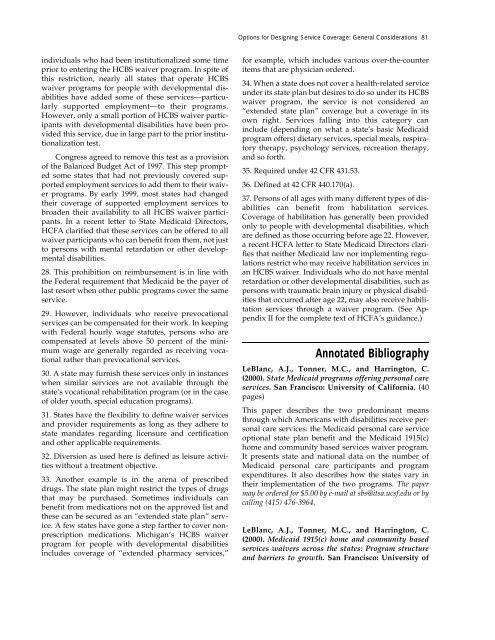Full PDF Version - ASPE - U.S. Department of Health and Human ...
Full PDF Version - ASPE - U.S. Department of Health and Human ...
Full PDF Version - ASPE - U.S. Department of Health and Human ...
- No tags were found...
You also want an ePaper? Increase the reach of your titles
YUMPU automatically turns print PDFs into web optimized ePapers that Google loves.
Options for Designing Service Coverage: General Considerations 81individuals who had been institutionalized some timeprior to entering the HCBS waiver program. In spite <strong>of</strong>this restriction, nearly all states that operate HCBSwaiver programs for people with developmental disabilitieshave added some <strong>of</strong> these services—particularlysupported employment—to their programs.However, only a small portion <strong>of</strong> HCBS waiver participantswith developmental disabilities have been providedthis service, due in large part to the prior institutionalizationtest.Congress agreed to remove this test as a provision<strong>of</strong> the Balanced Budget Act <strong>of</strong> 1997. This step promptedsome states that had not previously covered supportedemployment services to add them to their waiverprograms. By early 1999, most states had changedtheir coverage <strong>of</strong> supported employment services tobroaden their availability to all HCBS waiver participants.In a recent letter to State Medicaid Directors,HCFA clarified that these services can be <strong>of</strong>fered to allwaiver participants who can benefit from them, not justto persons with mental retardation or other developmentaldisabilities.28. This prohibition on reimbursement is in line withthe Federal requirement that Medicaid be the payer <strong>of</strong>last resort when other public programs cover the sameservice.29. However, individuals who receive prevocationalservices can be compensated for their work. In keepingwith Federal hourly wage statutes, persons who arecompensated at levels above 50 percent <strong>of</strong> the minimumwage are generally regarded as receiving vocationalrather than prevocational services.30. A state may furnish these services only in instanceswhen similar services are not available through thestate’s vocational rehabilitation program (or in the case<strong>of</strong> older youth, special education programs).31. States have the flexibility to define waiver services<strong>and</strong> provider requirements as long as they adhere tostate m<strong>and</strong>ates regarding licensure <strong>and</strong> certification<strong>and</strong> other applicable requirements.32. Diversion as used here is defined as leisure activitieswithout a treatment objective.33. Another example is in the arena <strong>of</strong> prescribeddrugs. The state plan might restrict the types <strong>of</strong> drugsthat may be purchased. Sometimes individuals canbenefit from medications not on the approved list <strong>and</strong>these can be secured as an “extended state plan” service.A few states have gone a step farther to cover nonprescriptionmedications. Michigan’s HCBS waiverprogram for people with developmental disabilitiesincludes coverage <strong>of</strong> “extended pharmacy services,”for example, which includes various over-the-counteritems that are physician ordered.34. When a state does not cover a health-related serviceunder its state plan but desires to do so under its HCBSwaiver program, the service is not considered an“extended state plan” coverage but a coverage in itsown right. Services falling into this category caninclude (depending on what a state’s basic Medicaidprogram <strong>of</strong>fers) dietary services, special meals, respiratorytherapy, psychology services, recreation therapy,<strong>and</strong> so forth.35. Required under 42 CFR 431.53.36. Defined at 42 CFR 440.170(a).37. Persons <strong>of</strong> all ages with many different types <strong>of</strong> disabilitiescan benefit from habilitation services.Coverage <strong>of</strong> habilitation has generally been providedonly to people with developmental disabilities, whichare defined as those occurring before age 22. However,a recent HCFA letter to State Medicaid Directors clarifiesthat neither Medicaid law nor implementing regulationsrestrict who may receive habilitation services inan HCBS waiver. Individuals who do not have mentalretardation or other developmental disabilities, such aspersons with traumatic brain injury or physical disabilitiesthat occurred after age 22, may also receive habilitationservices through a waiver program. (See AppendixII for the complete text <strong>of</strong> HCFA’s guidance.)Annotated BibliographyLeBlanc, A.J., Tonner, M.C., <strong>and</strong> Harrington, C.(2000). State Medicaid programs <strong>of</strong>fering personal careservices. San Francisco: University <strong>of</strong> California. (40pages)This paper describes the two predominant meansthrough which Americans with disabilities receive personalcare services: the Medicaid personal care serviceoptional state plan benefit <strong>and</strong> the Medicaid 1915(c)home <strong>and</strong> community based services waiver program.It presents state <strong>and</strong> national data on the number <strong>of</strong>Medicaid personal care participants <strong>and</strong> programexpenditures. It also describes how the states vary intheir implementation <strong>of</strong> the two programs. The papermay be ordered for $5.00 by e-mail at sbs@itsa.ucsf.edu or bycalling (415) 476-3964.LeBlanc, A.J., Tonner, M.C., <strong>and</strong> Harrington, C.(2000). Medicaid 1915(c) home <strong>and</strong> community basedservices waivers across the states: Program structure<strong>and</strong> barriers to growth. San Francisco: University <strong>of</strong>
















